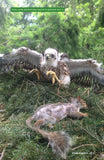
Raptor Prey Remains
A Guide to Identifying What’s Been Eaten by a Bird of Prey
- Practical tips for identifying over 100 commonly found prey species
- Over 750 detailed colour photographs
- Clues to identifying the raptor, and fieldwork tips
- The book you have all been waiting for! This makes life so easy when you find remains in your garden or out in the countryside... A must-have.
—John Miles, Birdwatching
- birds
- ecology
- natural history
- ornithology
- popular wildlife
- prey
- raptor
Description
Are you curious about the remains of an animal you have found? This compilation of the most likely found body parts of animals eaten by raptors will help you identify your discovery. Including over 100 species of bird and mammal prey of raptors such as sparrowhawks, peregrines and hen harriers, this photographic guide highlights the common feathers, fur and other body parts found at raptor nests, roosts, plucking posts and other opportunistic spots.
Discovering what raptors eat is an important part of confirming their feeding ecology and how this might change over time, vary on a local level or in response to changing prey populations, as well as dispelling myths and assumptions about what certain raptor species eat. Diet studies are vital for the conservation of raptor species; the more we know about what they need for survival the more we can predict and plan long-term for the protection and survival of raptors that may be vulnerable and in decline.
This is the first book to show in detail the actual parts of a bird, mammal or other animal that you are likely to find in a garden, woodland or beneath a raptor roost. As more people take an interest in raptors and watch species such as peregrines via webcams and through watch groups, there is greater opportunity for finding prey remains. This book provides the first and most important step in identifying a prey species.
Readership
Anyone interested in birds of prey, animal tracks and signs or bird behaviour.Table of Contents
Introduction
Finding and identifying raptor prey remains
--Where to begin
--Who’s been at work? A mammal or bird predator?
--Signs of predation
--Visiting regular prey sites
--Collecting safely
--Working out how many individuals of species you have
--Building up a reference collection and protecting from insects
--What clues do different raptors leave behind?
--Other resources for identifying prey
--My own story – learning my feathers and identifying peregrine prey
Parts of a bird
Glossary
Prey species
Reviews
- The book you have all been waiting for! This makes life so easy when you find remains in your garden or out in the countryside... A must-have.
—John Miles, Birdwatching - It is certainly interesting to see the resultant feathers and other remains, and, from that to be able to use this book to see the bird breakfast some passing sparrowhawk or peregrine has had... A welcome addition to serious birders’ bookshelves.
—Bo Beolens, Fatbirder - The bulk of the book consists of images of bits of over 100 species, mostly birds, that you might find in raptor nests or on plucking posts. These concentrate on those parts of the bird you are most likely to encounter under such circumstances and which are of most help in clinching identification. They are fascinating – truly fascinating.
—Mark Avery - This is a book that may appeal to raptor workers or other ecologists as a reference tool in the exciting whodunnit mysteries that prey remains present to those of us with a fascination for such things.
—Anthony Wetherhill, British Trust for Ornithology - Lots of pictures… good general instructions
—Pertti Koskimies, Linnut Magazine - The text is concise but helpful, drawing attention to the key features to look out for... This is a good, accessible introduction to this subject. It provides a good feel for the types of remains worth looking out for, and it will be of great help in identifying the more commonly found species.
—Ian Carter, British Birds - It should please any aspiring nature detective, and there is a certain gory fascination here for any birder.
—Will Cresswell, Scottish Birds - A must have for all European raptor researchers. I wish we had a book like this for North America!
—The Birdbooker Report - Drewitt’s passion and knowledge are evident. His work sparks inquiry and offers insight into why raptor prey remains are worth contemplation.
—Melissa T. Yang, American Birding Association
About the Author
Ed Drewitt has been collecting feathers and skulls since he was seven years old and studying the diet of urban peregrines for over twenty years. He has a good eye for identifying even the tiniest of feathers and has learnt which body parts we are most likely to find after a raptor has fed.
Bibliographic Information
 230 pages
230 pages - 762 colour photographs
- BISAC SCI070040, NAT004000, NAT043000
- BIC PSVW6, WNCB






















